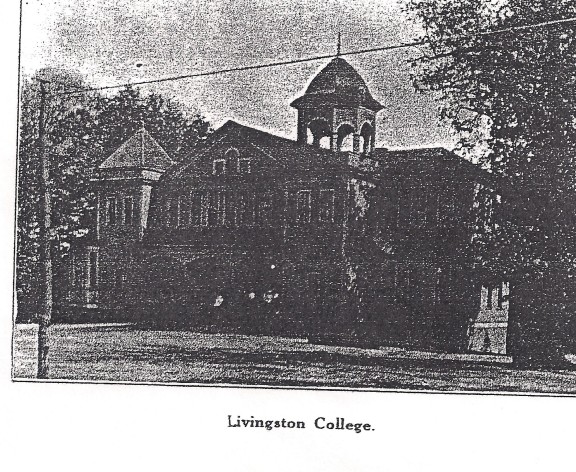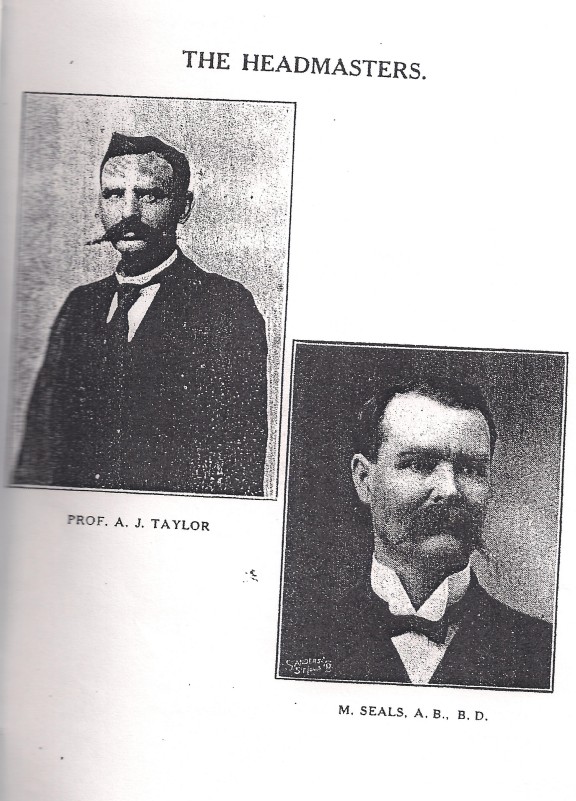The 100th birthday of Livingston Academy was recently celebrated, and I found it interesting that in what I read concerning the history of the school, there was never anything mentioned about what must have been its predecessor, a school known as "Livingston College." Information contained in a booklet recently shared with me about Livingston College says that on September 16, 1907, it would open for a ten month term. This would be some two years prior to the commencement of Livingston Academy. Upon first glance, the words "Livingston College" would indicate to most that this school was one for those who were already high school graduates. After a closer inspection of the booklet, that turns out not to be the case. A "Classical Course" is offered for grades first through third. "Intermediate" covers grades four and five. "Advanced Grades" are classified as sixth to eighth. "High School" lists grades nine and ten. Tuition per month was charged as follows:
Primary (Grades One to Three) ... $1.25
Intermediate (Grades Four and Five) ... $2.00
Advanced (Grades Six to Eight) ... $3.00
High School (Grades Nine and Ten) ... $3.50
Training School ... $4.00
Pedagogy ... free to students
Business Course ... $5.00
Young Ladies’ Course ... write for terms

A printed booklet describes the school as undenominational and has this to say:
"We now bring the best educational advantages to your door at a very low rate for a first-class school. The school is situated among a hospitable people in a small town, free from the view of corrupting influences of the city, splendid in climate, excellent water, good church facilities, and a moral environment. This school offers advantages not offered in any school on the Highland rim between Tullahoma, Tennessee and Albany, Kentucky, being the only one that prepares for a university. This department will be managed so as to give the most thorough drill in the fundamentals of a higher education. The price of tuition places these advantages within the reach of everybody. Those studying for a career will gain much time by being thoroughly drilled in the basic principles of education before taking up their specialty. Those desiring the degrees of B.S. may substitute German for Greek."
The booklet describes the town of Livingston as follows:
"Livingston, the county seat of Overton County, Tennessee, is a thriving town of a thousand inhabitants, situated on the Highland Rim in the sight of the foothills of the Cumberland Plateau. It is surrounded by dense virgin forests, underlaid with a variety of useful minerals. Livingston is at the north terminus of the Overton County Railroad, 16 miles from Algood, Tenn., a junction on the Southern Railroad. Many manufacturing plans are located here giving the town an industrial appearance. The people are alive to all interests that have a tendency to give substantial growth to the town. Limestone, freestone, white sulphur, black sulphur and chalybeate water abound." (The term "chalybeate" was not something I’m familiar with, so I looked it up. The definition says: "An adjective denoting natural mineral springs containing iron salts.")
The Headmasters of Livingston College for 1907-1908 were Professor A.J. Taylor and M. Seals. A sketch of Professor Taylor says:
"A.J. Taylor, the present County Superintendent of Overton County, has had twenty years experience as teacher in the schools of this and adjoining counties. He was a student for years of the matchless Joe McMillin, of Mont Vale Academy, Celina, Tennessee. Desiring a first-class business education, he attended the Commercial College of Lexington, Kentucky, graduating in the Smith System of Bookkeeping and General Business. This system has always taken the award against all competitors. The latter part of his school life was spent under the world-famous Alfred Holbrook, of the National Normal University of Lebanon, Ohio. Holbrook was the introducer of Normalism in America. A.J. Taylor has had charge of the high school here for several years." (This last sentence is interesting ... what was the name of the high school referred to here in light of the fact that Livingston Academy did not yet exist?)
M. Seals is described as the "elected co-principal with Professor A.J. Taylor, and has had twelve years experience as a teacher, having taught the past year in the Cookeville public schools. He was graduated A.B. at Alpine Institute, 1891, and B.D. at Cumberland University, the course including Elocution. He took a course from the American Institute of Sacred Literature of Chicago University, and a graduate course in Psychology from the American Institute of Sciences. He has recommendations from W.N. Billingsley, President of Burritt College; R.L. Jones, now State Superintendent of Public Instruction; Honorable A.H. Roberts; ex-congressman H.C. Snodgrass, and many others."

Miss Beulah Kikpatrick was in charge of the Music Department, and the booklet says that she had "studied from our leading German professors and holds a diploma from the Tennessee Academy of Music." Tuition for the music course was $3.50 per month.
Information in reference to a Ladies’ Department reads as follows:
"We have arranged a special course for young ladies. It embraces the tenth grade, except Algebra, Geometry and Greek. Instead of these, there is required at least two years in Music and one year in Art, which will be taught in connection with the other work of this institution, thus giving special advantages to young ladies who attend school. Most schools have no arrangement, as we have, in the curriculum to give time for Music or Art, thus overworking their pupils. The advantages of this department should not be overlooked."
A paragraph on "Vocal Music and Elocution" (the skill of clear and expressive speech, especially of distinct pronunciation and articulation) states this course will be taught by a teacher who has taken "Elocution" for three years under a graduate of the Emerson College of Oratory of Boston. The name of the teacher was not given.
Professor A.J. Taylor and wife Nora Taylor, grandparents of Cato Taylor of Livingston, once owned what is now one of Livingston’s oldest homes still standing. Professor Taylor is believed to be the person who had the home constructed. Harlon H. Taylor, a son of Professor Taylor, was the second generation of the Taylor family to own the home. A third generation, Cato Taylor, and wife Lola Belle, and their four children, Edward N. Taylor, W.S. Taylor, H. D. Taylor, and Rebecca Taylor Hubbard, owned and lived in the house for many years. It was purchased in 1979 by Ralph Hutcheson and wife Margaret (McCormick) Hutcheson, and then sold to Arlice Huffer and wife Betty Huffer in 1991. Located at 1009 East Main Street in Livingston, the home is presently owned by Kelly Hammock and wife Anita Hammock.
Another interesting document found on record in the Register’s Office of Overton County is a Charter of Incorporation for the Cordell Hull Junior College, an educational institution. Founding members who signed the charter of incorporation were:
A.F. Officer; Mrs. A.B. Qualls; Dr. W.M. Brown; Sam Coward; Dr. C.H. Dowell; Artie Hodges; J. H. Myers; H. H. Patterson; Cato Taylor; Benton Young, and J. C. Taylor. The charter was signed on June 21, 1941. The charter says that "the purpose of this institution is to provide educational opportunities for young people, primarily for those young people of the Cumberland Mountain area who, because of limited means, are unable to attend any other institution of learning. Also, it is to serve as a living monument to Tennessee’s most distinguished citizen, Cordell Hull, who is a native of the area that the school is designed to serve. This corporation is located at Livingston, Overton County, Tennessee."
The exact location of the Cordell Hull Junior College is not given, but it may have been that the existing high school building might have been used. Other than the charter on file in the Register’s Office, nothing else seems to be known about this institution.
If it were possible to step back in time long enough to sit in on one of these classes, I think it would be interesting to listen to Livingston College’s instructor of the "Elocution" class, someone who had studied under a graduate of the Emerson College of Oratory of Boston. Just how did that teacher go about teaching students of this mountainous area "the skill of clear and expressive speech, especially of distinct pronunciation and articulation" in 1907? And if a brochure had to be written today describing this area, would it include the statement from the college booklet ... "The school is situated among a hospitable people in a small town, free from the view of corrupting influences of the city, splendid in climate, excellent water, good church facilities, and a moral environment."
Evidently neither Livingston College or Cordell Hull Junior College were very successful, but thankfully, just a tad of information was left behind so that many years later, we might at least know of their existence, and to be able to catch just a glimpse of a very different life style that was lived back then. The Livingston College booklet ends with a quote from Channing ... "There is nothing on earth so precious as the mind, soul, and character of a child."